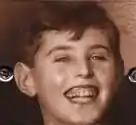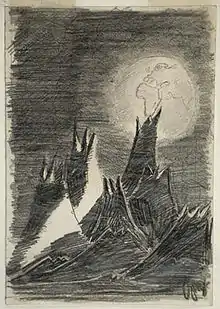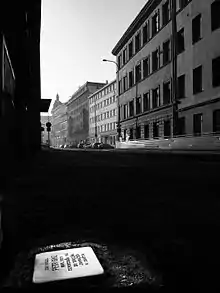Petr Ginz
Petr Ginz (1 February 1928 – 28 September 1944) was a Czechoslovak boy of partial Jewish background who was deported to the Theresienstadt concentration camp (known as Terezín, in Czech) during the Holocaust. He died at the age of sixteen when he was transferred to Auschwitz concentration camp and gassed to death upon arrival. His diary was published after his death.
Petr Ginz | |
|---|---|
 Petr Ginz | |
| Born | 1 February 1928 |
| Died | 28 September 1944 (aged 16) |
| Cause of death | Gassed to death |
| Resting place | Auschwitz concentration camp, Oświęcim, Poland |
| Occupation | Diarist, writer |
| Known for | Paintings and writings |
Life

Petr was born into the family of Otto Ginz, a manager of the export department of a textile company from Prague and notable Esperantist, and Marie Ginz (née Dolanská).[1] Petr's father was Jewish, and his mother was not. His parents met at an Esperantist congress. His mother was from Hradec Králové where her father was a village teacher. Petr got frequent visits from his relatives during Christmas including his grandfather who owned an antique shop in Jungmann Square where he sold rare books. Petr was a very intelligent boy; between the ages of 8 and 14 he wrote 5 novels: From Prague to China, The Wizard from Altay Mountains, Around the World in One Second and A Visit from Prehistory — the only surviving novel today. The novels, including Návštěva z pravěku (English: Visit from Prehistory), were written in the style of Jules Verne[2] and illustrated with his own paintings. He was interested in the sciences and yearned for knowledge. Because of his parents' interest in Esperanto, this was one of the native languages of Petr (the other one being Czech).
According to the anti-Jewish laws of the Third Reich, children from mixed marriages were to be deported to a concentration camp at the age of 14. Young Petr was transported to the Theresienstadt concentration camp in October 1942. His efforts in sciences and thirst for knowledge remained and he tried to study even in the concentration camp. He often read from the library full of confiscated books to which he had access. He was placed in the Domov č.1 (Home No. 1, building L417).[1] He became one of the most significant individuals of the community.[3] He established and prepared for publication the periodical magazine Vedem which means "We Lead." He also wrote an Esperanto–Czech dictionary as well as several other short novels that have been lost. One such piece of writing is called 'The Rambles through Theresienstadt' where he interviews and comments on people, buildings and even the crematorium.
The breadth of his interests, abilities and character are determined from his writings that remain and from the testimonials of friends who survived. He was interested in literature, history, paintings, geography, sociology and also in the technical fields. The magazine Vedem was published every Friday for two years.[2]
Petr was assigned to one of the last transports to Auschwitz concentration camp from Terezín, where he died in the gas chambers in 1944. His diary has been published in English under the name: The Diary of Petr Ginz 1941–1942.
Vedem
The magazine was founded shortly after his arrival at Terezín in 1942. Besides Ginz, several other boys from the Domov č.1. also contributed. Petr Ginz became a chief editor and he contributed under the code name nz or Akademie (Academy). One of his closest collaborators was Hanuš Hachenburg who wrote many poems. Ginz gave most of his writings and paintings to his sister before his transport, so a majority have survived to today.[1] His sister was also deported to Terezín in 1944, but she survived.[1]
Diary
.JPG.webp)
Before his transport, Ginz wrote a diary between 1941 and 1942 about his life. This diary, written in a matter-of-fact way, has been compared to that of Anne Frank. This diary was lost but found and published by his sister Eva (now Chava Pressburger) as Diary of My Brother. It was published in Spanish, Catalan, and Esperanto, as well as the original Czech, and in English in April 2007 as The Diary of Petr Ginz 1941–1942. A review appeared in an issue of The New York Times dated Tuesday 10 April 2007.
Drawing
Israeli astronaut Ilan Ramon, whose mother and grandmother were survivors of Auschwitz, was asked by S. Isaac Mekel, director of development at the American Society for Yad Vashem, to take an item from Yad Vashem onto the American Space Shuttle Columbia.[2] Ramon carried with him a copy of a drawing by Ginz of the planet Earth as seen from the Moon. The shuttle, while reentering Earth's atmosphere, broke apart on 1 February 2003,[4] destroying the copy of Ginz's drawing on what would have been his 75th birthday. In 2018, 15 years after the Space Shuttle Columbia disaster, another copy was given by Yad Vashem to Ilan's widow, Rona, to give to astronaut Andrew Feustel. Feustel carried it to space during Expedition 56 in memory of Ginz and Ramon. Feustel's video message commemorating Holocaust Remembrance Day (Yom HaShoah) 2018/5778 featured the astronaut displaying Ginz's depiction of a view of Earth from the Moon.[5][6][7]
Petr Ginz's drawing and its fateful history have inspired other pieces of art. One example is the painting Variation on Petr Ginz's Moon Landscape (2008) by Panamanian artist Roberto Perez-Franco.[8]
Legacy

The asteroid 50413 Petrginz was named in his honour.
In 2005 the Czech Post edited a 31 KČ stamp with the Moon drawing and a portrait in remembrance of Petr Ginz.
A Stolperstein by German artist Gunter Demnig was installed in his honor in Prague.
His life was commemorated in a 2012 documentary film, The Last Flight of Petr Ginz, directed by Sandra Dickson and Churchill Roberts.[9]
References
- "Petr Ginz's story". Holocaust.cz. Archived from the original on September 22, 2012. Retrieved April 14, 2011.
- "Reflex about Ginz" (in Czech). Reflex.cz. Archived from the original on October 30, 2008. Retrieved April 14, 2011.
- Kalendová, Helena (January 14, 2017). "Petr Ginz a jeho Měsíční krajina: Židovský chlapec, jehož kresbu vynesli do vesmíru" (in Czech). Retrieved November 14, 2018.
- "Columbia tragedy". Archived from the original on June 11, 2008. Retrieved June 11, 2008.CS1 maint: bot: original URL status unknown (link)
- "Fulfilling the dream of Ilan Ramon (in Hebrew)". Israel Hayom. January 31, 2018.
- Garcia, Mark (April 12, 2018). "Astronaut Drew Feustel Honors Holocaust Remembrance Day with a Replica of Drawing First Flown in Space by the Late Ilan Ramon". NASA. Retrieved April 12, 2018.
- https://www.jta.org/2018/04/12/news-opinion/united-states/us-astronaut-records-holocaust-remembrance-message-space
- Variation on Petr Ginz's Moon Landscape
- The Last Flight of Petr Ginz at IMDb
External links
| Wikimedia Commons has media related to Petr Ginz. |
- The Diary of Petr Ginz (ISBN 0-871-139669 published in English in 2007)
- Moon Landscape (the drawing)
- Petr Ginz – Theresienstadt at Yad Vashem Museum
- The Last Flight of Petr Ginz (2011 documentary film)
- The Last Flight of Petr Ginz, UN Study Guide.
- Documents about Petr Ginz in the collection of the Jewish Museum Prague.
- Petr Ginz's entry at the Find a Grave website